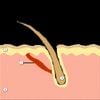Intermolecular NH2-/Carboxyl-Terminal Interactions in Androgen Receptor Dimerization Revealed by Mutations That Cause Androgen Insensitivity
January 1998
in “
Journal of biological chemistry/The Journal of biological chemistry
”
TLDR Mutations at Val-889 and Arg-752 disrupt key interactions in the androgen receptor, affecting its function.
The study investigated the structural alignment of the human androgen receptor dimer by introducing mutations in the steroid binding domain that cause androgen insensitivity. These mutations did not affect androgen binding affinity but increased the dissociation rates of [^3H]methyltrienolone and required higher dihydrotestosterone concentrations for transcriptional activation. In mammalian cells, the steroid binding domain interacted with an NH2-terminal-DNA binding domain fragment and the full-length androgen receptor in a dose-dependent manner. Mutations at Val-889 and Arg-752 disrupted the NH2-/carboxyl-terminal interaction in the steroid binding domain fragment but not in the full-length receptor. This interaction reduced the dissociation rate of bound androgen and slowed the degradation of the steroid binding domain fragment, indicating that Val-889 and Arg-752 are crucial for the NH2-/carboxyl-terminal interaction and suggesting an antiparallel arrangement of androgen receptor monomers during dimerization.
